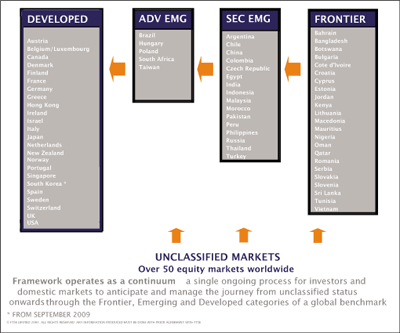Navigate your way to the new frontier

Most investors agree on what constitutes a developed market but the picture can become more hazy when it comes to emerging and frontier markets. Frontier markets carry higher levels of risk, but can also offer very high returns. A key tool for investors to use as they approach the Frontier markets is a transparent and codified system for country classification
As traditional emerging markets “emerge” and begin to take on the risk and return characteristics of their developed counterparts, many investors are turning their attention to nascent equity markets to replace them on the efficient frontier curve. “Frontier” is a good term to describe these rather disparate markets characterized by high volatility, low liquidity and sometimes spectacular performance returns. How do you know you’ve reached the Frontier? There is general agreement that frontier markets entail both higher levels of risk and higher returns. They also have low correlation to emerging and developed markets. However, how do investors define what is and what isn’t a frontier market? Though most investors agree on what developed markets are, consensus declines as you move along the spectrum through the emerging category and on towards the frontier tail. It is clear, therefore, that investors will benefit from having at their disposal a robust and objective country classification system which can be used to assign countries to Developed, Emerging and Frontier categories within their international investment portfolios. With such a system in place, investors can gain a more objective understanding of the risk and return profile of markets into which they are considering investing. What makes a good Country Classification system? A country classification system should be robust enough to span the continuum from a developed category to emerging to frontier and then beyond. Furthermore, it should allow for the promotion and demotion into and out of these categories. There should be an engagement process whereby the needs of international investors are communicated to the exchanges and regulatory authorities of the countries in the form of rules or criteria. FTSE Group (“FTSE”) uses a comprehensive, rules-based approach to country classification, alongside an ongoing market-wide engagement process, making it well positioned to define what constitutes a developed, emerging or frontier market. This framework, which is used to classify markets for inclusion in the FTSE Global Equity Index Series, defines the status of a country based on their relative wealth as well as the quality of their market infrastructure. For a country classification system to be truly accurate, it needs to be updated on a regular basis. FTSE reviews markets annually against the quality of market criteria and publishes the results in a transparent matrix format. Changes resulting from the recent September 2008 Country Classification review included South Korea winning promotion to Developed status, and a new set of 8 markets being added to the Watch List for possible promotion or demotion next year. As you consider whether to venture towards the new frontier, you need to think carefully about which benchmark you select to measure the performance of your investment and, in particular, the extent to which your benchmark provider is using a robust Country Classification system.




